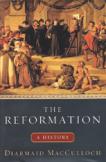The Great Western Upheaval
“In its field it is the best book ever written.” That was the most enthusiastic of the many enthusiastic assessments that greeted MacCulloch’s book when it appeared in Britain last year. It is an assessment with which I agree. The book is a monumental achievement that takes readers through the familiar parts of the story of the Reformation but then leads them far beyond those parts—both backward into the late Middle Ages and forward into the 18th century—and, briefly, even beyond.
The book ends, in fact, with reflections on Paul VI’s encyclical Humanae Vitae, on the pontificate of John Paul II, and similarly contemporary phenomena. As those reflections suggest, MacCulluch’s point throughout the book is that “The Reformation and the Counter-Reformation are far from dead” (p. 678). That is a conviction shared by all historians of the era, but none have tried to draw out its implications in one volume the way MacCulloch does.
The author is a fellow of St. Cross College, Oxford, and a professor of church history at the university. His speciality is England, and his books include the award-winning Thomas Cramner: A Life. The present book is especially striking for how up-to-date it is on a wide variety of subjects, which surely is due in part to MacCulloch’s editorship of the Journal of Ecclesiastical History, which has kept him abreast of research almost as it rolls off the press. He says in his Introduction that he hopes his book will liberate for a wider public the research locked up inside the world of specialists. He has succeeded.
He divides the book into three parts. The first, “A Common Culture,” takes us from the late Middle Ages through the Reformation. The second, “Europe Divided, 1570-1619,” describes the creation of the distinctive religious cultures that followed upon the upheaval, now sometimes termed “confessionalization.” The third, “Patterns of Life,” is the most original in conception and treats issues that rarely make it into books on the Reformation. Some chapter titles from that part are “Changing Times,” “Death, Life, and Discipline,” and “Love and Sex: Staying the Same.” The final chapter, “Outcomes,” is the one that briskly sweeps us through the Enlightenment up to the present.
MacCulloch writes well. He has the gift of illustrating his points with ample and sometimes vivid detail without losing the reader. In the early pages, for instance, he masterfully describes the gross physicality of some late-medieval devotions, such as bucketsful of water poured on the congregation of a church in Bavaria as part of the celebration for Pentecost Sunday. For more abstruse points he proceeds with almost a schoolmaster’s patient, step-by-step exposition.
Such merits notwithstanding, this is not a book for everyone. It is long—800 very full pages. It could well be one of those books that tell you more than you want to know. Some parts are certainly better than others. I found the author’s presentation of Renaissance humanism, a subject that keeps popping up in the book, to be among the weaker ones. MacCulloch tries extremely hard to be fair to Catholicism, and in general he succeeds, as for instance with Archbishops Carranza, Charles Borromeo and Our Lady of Guadalupe. He is great on Teresa of Avila, John of the Cross and the Jesuits. When he gets into Catholic theology, however, he is sometimes just approximate, and he surprised me by consistently speaking of the “miracle of the mass” and the “miracle of transubstantiation.” He expresses strong opinions, with which of course not everybody will agree: the epicenter for the contemporary crisis in Christianity is the attitude of the churches toward different kinds of sexual behavior; both Catholicism and Protestantism were religions of “fear, anxiety, and guilt”; and similar judgments.
No historian can write a book of such scope and not fall into factual errors, and I noted a number of them. The nudes on the Sistine Ceiling never had their genitals painted over with fig leaves (nor did the Last Judgment, for that matter), and Savonarola’s “bonfires of the vanities” never destroyed some of the “finest products of Florentine Renaissance art.” But, as these examples suggest, the mistakes are inconsequential for the points MacCulloch is making and do not in the least detract from his overall accomplishment.
Though not a page-turner, Reformation is an important and stimulating book. You will need stamina to make your way through it, but if you persevere to the end, you will be happy you did. It is a book on the Reformation unlike any other.
This article also appeared in print, under the headline “The Great Western Upheaval,” in the October 18, 2004, issue.








